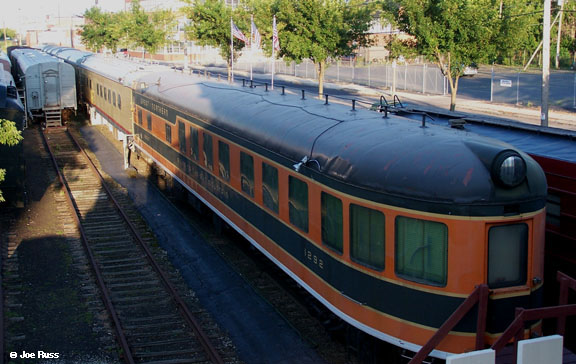
Why things were the way they were (or at least the way they were explained)
by Joe Russ

by Joe Russ
|
|
|
|
|
|
|
|
Why did you have to press the button for service?
This car was built in 1951, so it didn't have the electronics we now have. The
button system did two things: it notified the bartender which table needed to be
served, and would punch a tape that served as a cash register receipt. The
bartenders had to account for each punch on that tape.
Why did the bartender not like it when you pressed the button for service more
than once?
It added another order to the tape, and turned off the light for the table that was
supposed to be served, so he wouldn't know you wanted service.
Why couldn't you move furniture around?
Do you move furniture around when you go to a classy restaurant or lounge? Probably not. Plus, since this was
railroad furniture (i.e. heavy so it wouldn't move easily if the train stopped fast) a
patron could hurt themselves moving it, thus being a liability.
Why couldn't you change seats once you were seated?
The bartender did orders by table or seats, not faces, kind of like a restaurant. If you moved and he didn't
know about it, you messed up his ordering. And on top of that, moving around isn't very classy. If you want service like that, head to
Water Street.
Why does the bartender/waiter seem cranky?
He's not, really. But after dealing with the top four issues for half the night, you might be the same way. Both are really nice guys,
and a lot wiser and educated than you might think, so give them some respect and keep your (big) feet out of their way. By this point I too would get a bit
irritated, and figure the person was from someplace like Chicago or Kansas City.
Why didn't the bartender have you pay at the bar?
For security reasons and that's the way it was done when the car was in service. The staff is trying to serve you in proper fashion for the
period when the car was in operation.
Why did they close at midnight?
Since the Midwest Hiawatha was on an active railroad right-of-way, they were under federal regulations. And while that meant they
didn't need a local liquor license, they did have to follow the federal rules, which
ends service at midnight.
Why did the women's bathroom have a sliding door?
The bathroom was a converted roomette since the car originally only had one
bathroom. Had the toilet not been there, you could've dropped down the bed.
Why do you get to sit in the back of the car in the closed section?
Because a handful of us were good, loyal, long-term patrons who could answer all of the above questions. If we were back there the staff didn't
have to worry about pretzel fights, people playing with the TV, or anything else going wrong. Plus, air circulation in the car went from the back to the
front, so that was kind of the no smoking section.
And for some other questions I've heard since January 2002:
Why did it close?
I have some ideas, which I'll write someday, but I've never been given an answer by the people who worked there.
Why was it sold to a facility (Kansas City Union Station) which is having enough financial problems without taking on the
maintenance of historic railroad equipment?
That's a very good question, which I'm asking myself. But, this equipment is so rare that it will attract 250,000 poeple a year to KCUS... yeah, right, maybe for the first year.
The term "Pipe Dream" comes to mind. When I get a real answer I'll post it here.
Return to Schedule Board.
Return to Railfan News.

All text and photos by Joe Russ. Copyright © 2004 by Joe Russ